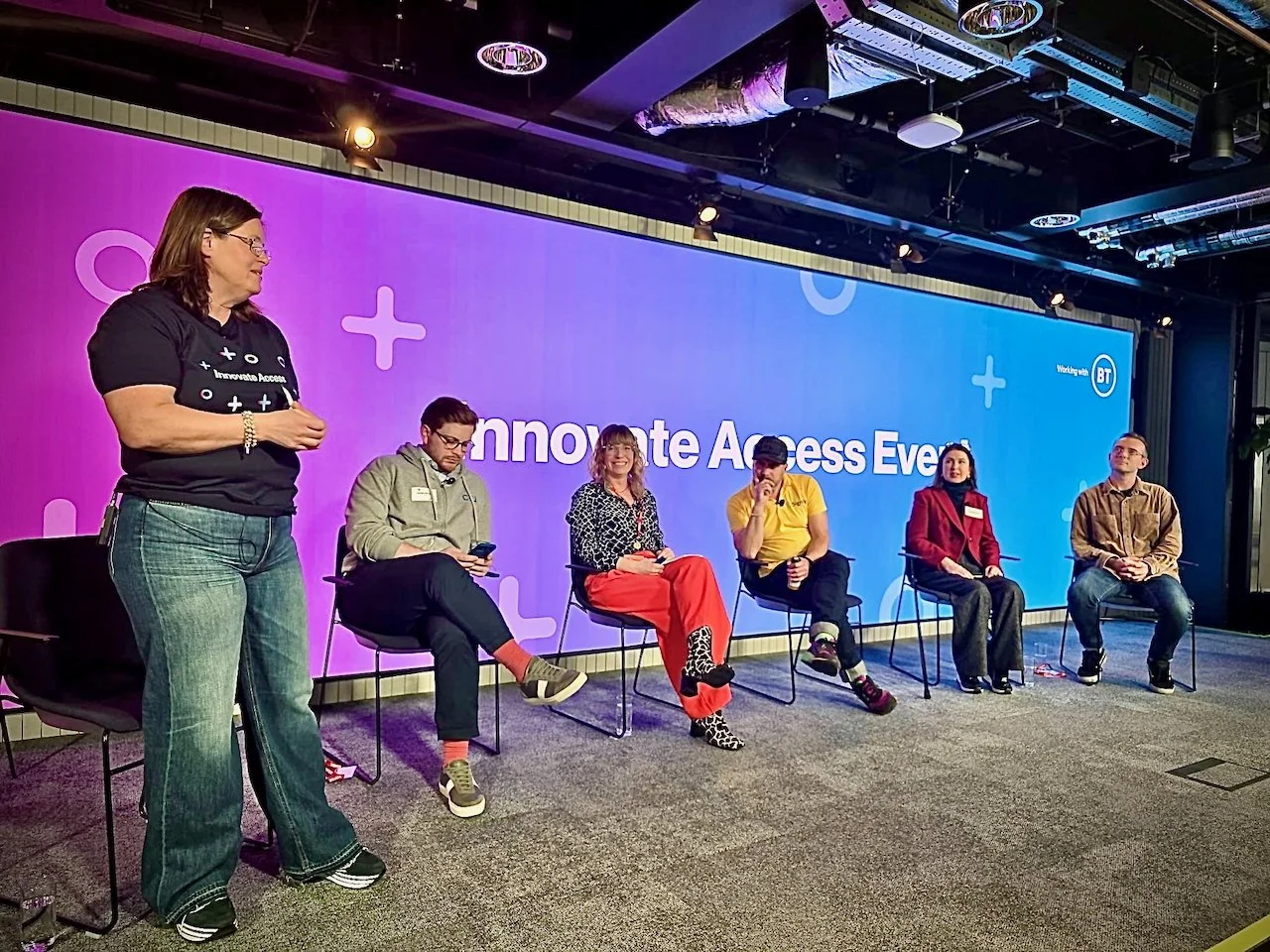AI, Assistive Technology, and Disability: How do you feel about AI right now?
🔟/10: Excited and already jumping in!
5️⃣/10: Interested but not sure where to start…
1️⃣/10: Fearful the robots will take over and all those sci-fi dystopias will come true!
As a disabled entrepreneur, I please myself at 10/10, not because I think AI is perfect, but because of what it enables me to do.
Founder, Michelle Scicluna, in matching Giraffe print shirt and boots and bright orange trousers, on stage at Innovate Access in London February 2025.
Why AI is a Game-Changer for Disabled Entrepreneurs
I can now progress in my business based on the quality of my thinking and ideation, rather than the sheer quantity of hours I can put in, and that’s a game-changer!
Like many disabled entrepreneurs, I know all too well the frustration of a longer cycle from idea to execution. When energy levels fluctuate and pacing is crucial to avoid medical condition flares, the traditional business narrative of "showing up consistently to succeed" can feel overwhelming and disheartening.
But AI helps me scale my intentions and deliver on my strategies more quickly by reducing the time spent on the "business of doing business". This means I can focus more of my time on the heart-led mission of my work, supporting disabled people and changing the world of work and business to make it more accessible and inclusive.
I believe AI has huge potential for creating a positive impact on our working lives, particularly for disabled people. As a minority group, disabled people are problem-solvers and innovators!
We navigate a world not set up for us and manage barriers to success that many people don’t even realise exist. These barriers are not only physical and overt, but also cultural, procedural, and attitudinal. This is why I am so excited about AI. It helps to leverage our skills in creative and innovative thinking, whist also helping to scale up our productivity and output.
Highlights from Innovate Access: AI & Assistive Tech for Disabled Entrepreneurs
Last week, I had the privilege of attending Innovate Access, an incredible event hosted by the brilliant Lilac Review and Small Business Britain, in collaboration with BT Group. Held at BT’s London HQ, the event explored AI and Assistive Tech’s role in supporting Disabled Entrepreneurs.
It was an inspiring day, packed with a stellar lineup of speakers who shared not just their expertise, but also their optimism about how AI is already supporting disabled entrepreneurs and its potential to elevate our contributions even further.
I learned from every single speaker that day, and I was grateful to be in a room with so many amazing disabled entrepreneurs!
One speaker, in particular, had me furiously scribbling notes. I want to share some of what I learned, not just because of her depth of knowledge and engaging presentation style, but also because of how she articulated both the opportunities and challenges of AI.
Dr Nicola Sims: The “Optimistic Futurologist”
Dr Nicola Sims from BT describes herself as half technologist, half psychologist - a Futurologist - how cool is that? #NewLifeGoal.
Nicola broke down AI’s history, consumer adoption trends, and the importance of a "human’s purpose-first" approach to AI, rather than a "tech-first" approach. In essence, be intentional about what you want to use AI for. AI should be a collaborator, not a replacement for your thinking.
One example she shared really illustrates this need to maintain you levels of engagement when using technology.
AI Gone Wrong: The Truck Driver Who Followed Sat Nav Too Literally
Nicola shared a story about a truck driver who followed their Sat Nav so literally that they wedged their truck between two buildings.
Instead of using their own judgment, they blindly trusted the machine—and got very literally stuck as a result.
This is exactly what we Nicola said we must avoid with AI. Instead of "tending to the machine" or slipping into "meta-cognitive laziness," we should be using AI to enhance and develop our own thinking, not replace it.
BTW - If you Google "truck driver gets stuck in lane", you’ll see tons of news stories about similar incidents across the UK. This wasn’t just one driver, there is a pattern of people following technology without engaging their own critical thinking.
How I use AI and Assistive Tech in My Business
Among an excellent lineup of speakers, I was also humbled to take the stage myself as part of a panel on AI and Assistive Tech—how I’ve used them so far and my advice for others looking to get started.
I shared how I’ve been using assistive tech for years to help me work with my health, rather than against it. From wearable tech that helps me check in with my health data and align tasks with my energy levels (instead of falling into boom-and-bust cycles), to my use of AI to leverage my way of thinking and scale my productivity and output.
As someone who tends to think by talking and learn by doing, assistive tech like speech-to-text software, when filtered through AI, has transformed the way I create written content. Together, they help me refine my thoughts, structure my ideas, and bring my work to life more efficiently, without compromising my voice or intent. As a combinaton, they remove many of the barriers of an energy-limiting disability; unlocking more opportunities and helping me focus more on what truly matters.
My Advice for AI Adoption: Be Curious and Critical
It took a couple of months to really train it on my voice, and that is the key advice I would share: consistently inputting my own thoughts and a lot of the prose I have written about coaching, work, business and disability since 2019, when I became certified to coach by Cambridge University.
It took a couple of months to really train my use of ChatGPT on my voice, and that is the key advice I would share: consistently inputting my own thoughts and a lot of the prose I have written about and for my coaching business and disability since 2019 when I became certified to coach by Cambridge University. This time and effort has really helped me refine my prompt strategies and direct AI to respond as another Michelle.
I also recommend approaching AI with a curious and critical mindset, play with it first, to find out what feels right to you personally. For me, ChatGPT seemed to learn faster and grasp my voice better, so I opted for the subscription. This decision was made not just for better access to the latest Language (LLM) and Reasoning Models, but also for the security it provides. The £20-a-month subscription stops feeding my work back into the LLM, which has helped me feel safe using it and ensured I don’t lose the unique authenticity I bring to the table.
That investment of time and £20 to cultivate the Michelle-ness of my AI co-pilot is yielding great results. But, I still need to be consciously alert each time I use it, to ensure I am still the pilot, and it remains the co-pilot and consider any bias I am building into it too. The reasoning model is great for that, to check my workings!
How Do You Feel About AI? Let’s Talk!
So, how do you feel about AI right now? Are you embracing it, experimenting with it, or still unsure? Let’s discuss in the comments below!

